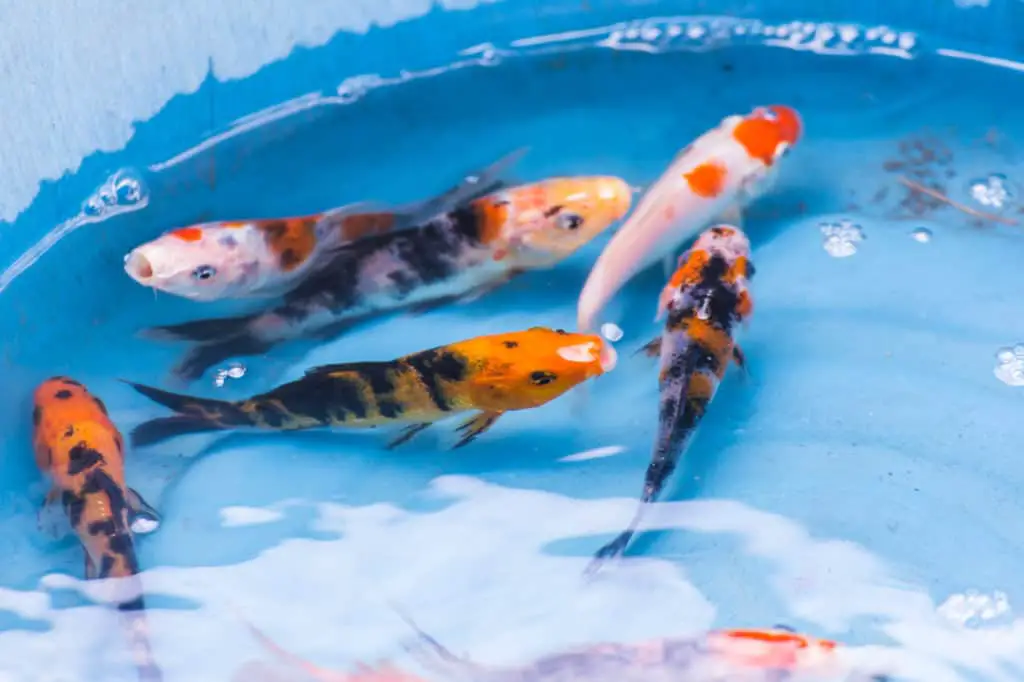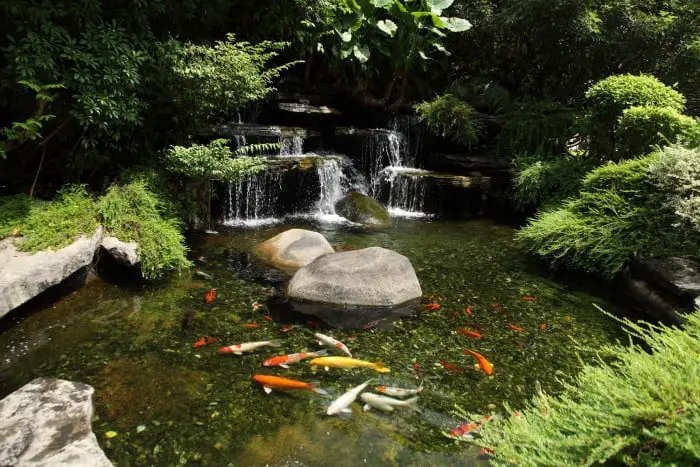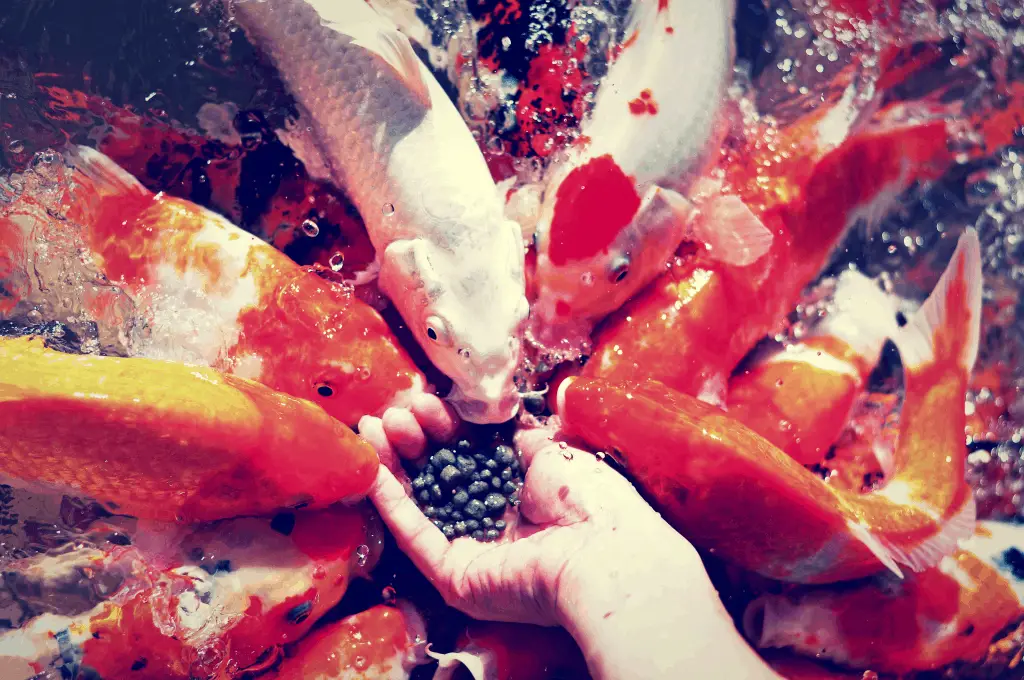Koi fish are a very popular ornamental fish and for good reason. They can be found in beautiful koi ponds across the world. One of their key characteristics that is hard to miss is their size. But just how big do koi fish get?
How Big Do Koi Get?
The largest koi known as jumbo koi can grow to more than 39 inches or 100 centimeters long! Chagoi Koi are among the largest of these jumbo koi and can exceed 48 inches or 123 centimeters in some cases. More typically the average Japanese koi fish can grow to about 24 inches or 61 centimeters long.
Koi in the one-year or less age range are known as Tosai. These tosai fingerlings can be anywhere from 3-8 inches in size depending upon quality. It usually takes at least 2 years for them to reach their full mature size.
How Fast Do Koi Grow?

How long does it take a koi fish to grow as large as they do? In their first year of growth, they can grow ¾ in (2 cm) per month reaching 9 in (3.5cm) by the end of the year. Koi in the one-year or less age range are known as Tosai. These tosai fingerlings can be anywhere from 3-8 inches in size depending upon quality.
It takes at least 3-4 years for a koi to reach a full mature size of about 2 feet. After this initial growth spurt, the koi’s growth will slow substantially. Additional growth will be about an inch per year and may slow even more in very old koi.
Keep in mind that this growth potential only occurs if they are properly cared for and all important factors are optimized. If their growth is stunted somehow in the first two years they may not reach full size at all.
What’s The World’s Biggest Koi Fish?
As we discussed above, quality Japanese jumbo koi can reach lengths exceeding 3 feet. But what is the world’s biggest koi fish?
Currently, the largest known koi fish is 4 feet in length and weighs a staggering 91 pounds! Affectionately known as “Big Girl” this amazing koi was purchased in 2007 from a specialist breeder in Japan. Her new owner is a koi shop owner from the UK where she now resides.
How To Make Koi Grow Faster & Bigger
The following are some tips to ensure your koi grow as big and as fast as possible.
- Buy your koi from a reputable breeder with a good track record
- Buy a jumbo koi breed
- Make sure to get some females
- Give them plenty of space
- Monitor water quality closely
- Maintain a water temperature of 77-80° F
- Keep them indoors during the winter if necessary
- Feed a high quality, high protein diet
- Feed small meals 5-6 times a day
- Limit stress
Factors That Influence How Big Koi Get
Not all koi will reach these large sizes. Many may not even reach the 2-foot mark. So what factors influence how large one of these jewels will reach? There are a handful of factors at play as you will read below.
Genetics
First and foremost, genetics are perhaps the most important factor that determines a koi’s potential size. Genetics are what determine the full potential of any living creature. A koi fish with poor genetics will never live up to a quality bred koi no matter the circumstances.
Japanese breeders are generally known for the biggest and the best koi. They have spent many generations selecting and breeding for the best genetics. While there are some domestic breeders of quality koi, many can not match the same standard as the Japanese.
The largest koi fall into the category of jumbo koi and can reach champion sizes. One such koi known for its large size is the Chagoi koi. These have excellent dispositions and can grow to over 3 feet long.
Sex
Female koi tend to get larger than male koi do. This is most apparent in overall body mass or girth. Sexing koi can be determined by looking at a few key attributes.
Size of the Pond

It is debatable whether or not pond size has an influence on the size of the koi in it. It is said that koi in small ponds will not grow as large as koi in big ponds. This isn’t entirely true.
An experienced, proactive, koi keeper can grow koi just as large in a small pond as someone could in a large pond.
The difference is how clean the water is kept and how well the koi are taken care of. A small pond will need more frequent monitoring, water changes, and so on. Therefore the more correct statement would be that it is EASIER to grow large koi in a large pond.
Large ponds need fewer water changes and less frequent maintenance. The water stays cleaner for longer allowing the fish to grow. A good rule of thumb is 250 gallons per koi with a depth of at least 3 feet.
Environment
As I alluded to in the above section environmental factors like water temperature & water quality play a role in how big koi will get.
Water Quality
Koi are large fish and produce a lot of waste. This waste turns into ammonia, nitrites, and nitrates. None of these caustic chemicals are good for the health of your koi. The higher these levels are the more your koi’s growth and health will be harmed.
This is why it’s important to keep a close eye on these chemicals by testing the water and doing frequent water changes. As stated above, you will have to do more frequent water changes in a small pond and fewer in a large pond.
Water Temperature
The temperature of the water directly affects a koi’s metabolism. This is because, like all fish, koi are cold-blooded.
The colder the water the slower the metabolism. The slower the metabolism, the slower the fish will grow. Many people in northern climates keep their koi in outdoor ponds all winter. This is perfectly fine and allows the koi to go through a hibernation period which may help the koi live longer. The downside to this is that their growth will slow substantially during this time.
Warmer temperatures on the other hand will allow their metabolism to speed up enabling them to eat more. This results in faster-growing, bigger koi. The ideal temperature for maximum koi growth is 77-80° F or 25-27° C.
If growth is a primary concern for you you may want to bring them indoors for the winter. Large heated stock tanks can be placed in the home or a garage. This will ensure they continue to grow throughout the year.
Nutrition

As the old saying goes “you are what you eat”. This isn’t just true for humans, it’s true for koi as well. If you feed them cheap, low quality, low protein feed they will not live up to their full potential.
You want to ensure you are feeding high-quality koi food. The best koi foods have the correct amounts of proteins, carbs, vitamins, and minerals. For best growth, you need to ensure the koi are being fed a diet of at least 30% protein with 45% being ideal.
Quality koi foods designed for maximum growth also contain things like enzymes and beneficial bacteria which aid in digestion.
It is also important to feed small amounts many times per day. As many as 6 feedings per day will maximize food intake and digestion. This can be accomplished with an automatic fish feeder designed for fish ponds.
Stress
Any one of the above factors if not optimized can lead to a stressed fish. Stress will cause a koi to eat less and be more prone to sickness.
Additional things that may cause undue stress are overcrowding (too many koi for pond size), perceived predators, and low dissolved oxygen.

